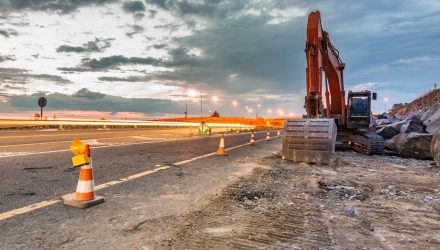Earlier this week, the Global X U.S. Infrastructure Development ETF (CBOE: PAVE) rallied after President Trump and congressional Democrats agreed to spend $2 trillion to improve America’s crumbling infrastructure.
It was a rare display of bipartisanship on Capitol Hill and one that, if executed properly, could benefit PAVE over the long haul because the exchange traded fund (ETF) is focused on domestic infrastructure companies and initiatives.
PAVE tries to reflect the performance of the Indxx U.S. Infrastructure Development Index, which is comprised of companies focused on domestic infrastructure development, including those involved in construction and engineering; production of infrastructure raw materials, composites and products; industrial transportation; and producers/distributors of heavy construction equipment.
How infrastructure dollars are spent is equally as important as knowing those dollars are earmarked for infrastructure in the first place.
“The needs are large so a $200 billion proposal would be a good start provided it represents a net increase in investment,” according to Fitch Ratings. “Every state, regional or local transportation, water or power department or independent authority can use an infusion of funds to accelerate projects already in planning and development.”
Huge Numbers for Infrastructure Spending
PAVE debuted shortly after President Trump won the White House, separating itself from rival infrastructure funds with its domestic focus. This year, PAVE is up about 22% and is gaining notoriety as the ideal way for investors to play what could be a substantial domestic infrastructure boom over the next few years.
During the 2016, presidential campaign, Trump promised to spend $1 trillion to shore up America’s sagging infrastructure, but politicians have clearly agreed to exceed that number. The spending required to refresh U.S. infrastructure is massive to say the least.
“Rebuilding a $20 trillion economy with a multi-trillion dollar investment gap will ultimately need an annual new investment of about $1 trillion a year for a while, i.e. 5% of GDP, to meaningfully catch-up,” said Fitch.
Still, it could take some time for infrastructure ETFs to see the full benefit of Trump’s still nascent infrastructure plans. Fortunately for PAVE, infrastructure demand exists without political wranglings.
“Politics aside, demand for infrastructure investment is driven by several factors, including demographic trends, depreciation of existing infrastructure, environmental risks, changing preferences and advances in technology,” notes Global X. “Accordingly, we explore the near- and long-term catalysts expected to fuel demand for infrastructure modernization in the United States for the foreseeable future.”
For more thematic investing strategies, visit our Thematic Investing Channel.

